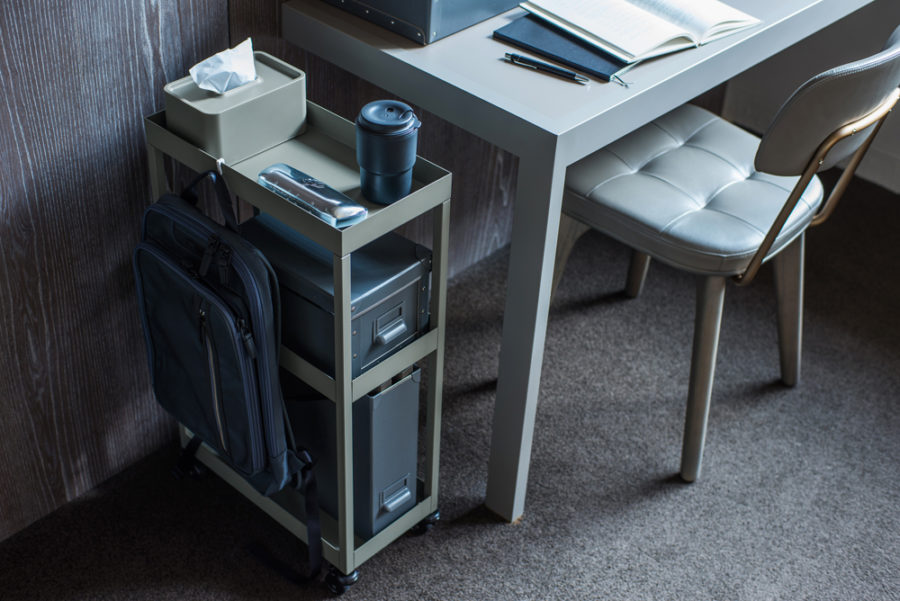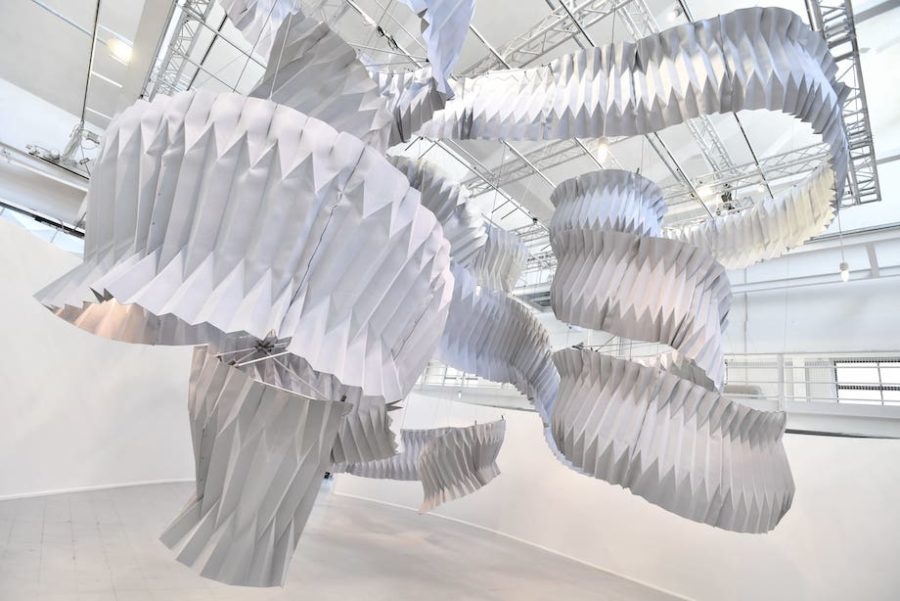
PRODUCT


© ICD University of Stuttgart
木材の特性「吸湿による収縮」を活かしたセルフシェイプ製造技術を開発する、ドイツの企業ハイロテック(hylo tech)が、組み立てすら不要な木製家具〈ハイグロシェイプ(HygroShape)〉を発表しました。2022年夏に数量限定で生産予定。
ハイロテックは、シュトゥットガルト大学のICDが進める、4Dマニュファクチャリング(3Dプリント+熱、光、湿度などの外部刺激)の研究から生まれたスピンオフ企業です。
HygroShape Self shaping wood furniture
(以下、hylo techから提供されたプレスキットのテキストの抄訳)
セルフシェイプ木製家具〈ハイグロシェイプ〉
〈ハイグロシェイプ〉は木が本来持っている「吸湿による収縮」の特性を活かし、梱包を解くと自ら変形するようプログラムされている。
人の手も道具も組み立て説明書すら不要であり、一晩で静かにスムーズに展開する木製家具である。また〈ハイグロシェイプ〉の形状は、一度成形するとロックされ、安定性を生み出す。

© ICD University of Stuttgart
このプロジェクトは、サステナブルな素材や手法を活用するため、「マテリアルプログラミング」を導入した設計・製造プロセスへの転換を意味している。これにより、自然の特性を取り入れた新たなデザイン言語が生まれた。ハイロテックは、この技術をインテリアや構造材に応用するための可能性を追求し続けている。

© ICD University of Stuttgart
4Dマニュファクチャリングとマテリアルプログラミング
木材は、体積や剛性の変化を含水率の変化と正確に関連付けることができる、プログラム可能な材料である。木材は湿潤時に膨張し、乾燥時に収縮する。これを考慮し、木造建築では一般的に、木材を乾燥させ変形を抑制してから使用される。
しかし、この現象を理解し利用することで、素材の力を活かした「強力かつ予測可能な動き」を生み出すことが可能となる。

© ICD University of Stuttgart
切り出されたばかりの木材は、当然ながら水分を多く含んでいる。この木材の内部構造をデジタル化することで、乾燥時にどのように変形するかを予測する。この情報をもとにコンピュータにより設計し、意図した挙動をするよう加工を施す。
これにより、室内に置くだけで自然乾燥し、特定の曲線形状をつくり出すことが可能となる。

© ICD University of Stuttgart
マテリアルプログラミングは、これまで捨てられていた機能を活かしながら、よりバリエーション豊かな天然素材の利用を可能にするプロセスである。
天然素材を分解し、ゼロから製造するのではなく、天然素材の挙動を理解し活用することで、資源や製造を効率化することができるのである。これは「バイオベース」というだけでなく、「バイオシェイプ」ともいえる手法である。

© ICD University of Stuttgart
「フラットパック」を超えた自律成形
歴史的に家具は、工場や職人の手で成形され、3Dのまま使用される住居に運ばれてきた。近年では、輸送コストの削減のため、パーツをコンパクトなパッケージに収め、エンドユーザーまで効率的に輸送する「フラットパック」というコンセプトで設計・製造されている。そのため、組み立てはユーザー自身が行うことになり、説明書や工具、時間が必要となる。

© ICD University of Stuttgart
一方〈ハイグロシェイプ〉は、素材に直接形状を埋め込むことで、シンプルで簡単な組み立てを可能にした、「新しいフラットパック」である。
各パーツは、厚さ3cm以下の非常に効率的なフラット状態で製造・輸送され、椅子の標準的な高さである50cmの高さに成形することができ、これは「容積が最大30倍」という驚異的な増加を示している。

© ICD University of Stuttgart
ラウンジチェア〈H1〉

© ICD University of Stuttgart

© ICD University of Stuttgart

© ICD University of Stuttgart

© ICD University of Stuttgart

© ICD University of Stuttgart

© ICD University of Stuttgart

© ICD University of Stuttgart
ロッキングチェア〈H2〉

© ICD University of Stuttgart

© ICD University of Stuttgart

© ICD University of Stuttgart

© ICD University of Stuttgart

© ICD University of Stuttgart

© ICD University of Stuttgart

© ICD University of Stuttgart

© ICD University of Stuttgart

© ICD University of Stuttgart
以下、hylo techのリリース(英文)です。
Project Description
HygroShape – Self-Shaping Wood Furniture
Bio-inspired, Bio-based, Bio-shaped
HygroShape is a first of its kind concept for truly self-shaping furniture. Using the natural, intrinsic properties of wood, furniture pieces are produced in physically programmed flatpack configurations, materially programmed to shape themselves when unpacked. This self-shaping emerges from the hygroscopic shrinkage that naturally occurs in wood materials. It happens effortlessly, in silence, without human interaction, tools, or assembly instructions, unfurling smoothly, as quickly as overnight.
Once shaped, the parts lock mechanically creating stability, while retaining an active ergonomic function through small harmonious movements. The project represents a shift in design and manufacturing processes implementing material programming to harness the unique potentials of sustainable materials and practices. With this comes a new material design language embracing the qualities and characteristics of the natural as an integrative expression of form and function.
The spin-off company hylo tech continues the exploration of this technology’s potential for a range of interior and structural applications.
Material programming for 4D wood manufacturing
HygroShape implements a novel material programming approach for digital design and fabrication in which functions such as movement are physically encoded inside the material system. Wood is taken as a highly programmable material in which a change in both volume and stiffness can be precisely correlated to a change in moisture content. This hygroscopic phenomenon is linked to the unique anisotropic fibrous composite composition of the wood cell walls which expand when wet and contract in drying, while at the same time provide remarkable strength to weight performance. Such properties are well known to the woodworker, as when unchecked in the drying process they can result in large uncontrolled deformations. Contrarily, here the forces are carefully understood and harnessed to generate strong, predictable movements powered directly by the material.
The HygroShape concept is based on the designed utilization of hygroscopic shrinkage that occurs in wood materials after they are harvested and equalize with the surrounding environment. Using highly tuned computational design methods, physical and mechanical material characteristics are digitized and used for calculating specific material syntax to direct the material towards a designed shaping sequence. From this specific syntax, flat, multi-ply wood buildups are produced with an intricate internal arrangement and moisture content. Pieces are then sealed and transported to the end-user, where exposure to an environment vastly different from the production, initiates the actuation sequence.
Freshly cut timber comes naturally with a high water content. If obtained directly, the wood can be processed and prepared in a way to maintain and optimize high moisture content during cutting and organizational steps informed by a digitization of the natural structuring. A computational design tool is then used to arrange specific boards in tailored layups intended to steer and coordinate the shaping that follows. Through this physical encoding each piece is programmed by a unique arrangement of boards and layers in its flat state to produce a specified curved geometry when moisture is reduced. Insitu, a simple exposure of the pieces to usual indoor climates induces natural drying as the wood material equalizes with its environment and smoothly shapes itself.
The material programming approach to fabrication alludes to a new type of manufacturing in which digital design is instinctively linked to the inflow of materials. A process that enables greater use of natural materials with higher variation while capitalizing on previously discarded functionality. By basing the process on understanding and directing the behaviors of natural materials, rather than breaking them down or engineering from scratch, the process opens the door to resource and manufacturing efficiency. The design potential in such a setup is enormous as the steps of digitizing, sorting and arrangement of material lead to a flexible and adaptable manufacturing sequence capable of parallel production of custom shapes and configurations.
Beyond flat pack, autonomous shaping and assembly
Historically furniture is shaped in a factory or by a craftsperson and then moved in its 3D form to the dwelling where it will be used. More recently, design and manufacturing has shifted to a flatpack concept in which collections of parts are produced specifically to nest in a compact flat package for efficient transport to the end user. This leaves the responsibility of assembly to the user, a process necessitating instructions, tools, and time. In parallel the design of flat pack furniture is directly limited by transport and manufacturing constraints. HygroShape introduces a new flatpack, one in which the shaping is embedded directly within the material itself, leading to a simple and effortless assembly. Each piece is manufactured and transported in a highly efficient flat state less than 3 cm in total thickness with the ability to shape to the height of 50 cm the standard height of a chair, which represents up to an astounding 30 times increase in the bounding volume.
Nature powered shaping
HygroShape furniture is built on core biomimetic principles found in the function of conifer cones (Pinopsida,strobilus) and the seed pods of beechnuts (Fagus sylvatica) which passively open to release their seeds. Each scale of the pine cone is constructed of an anisotropic fiber composite forming both protection from predators and a functional bilayer which when the cone is living maintains a high amount of water. However, when the cone falls from the tree the scales dry out causing them to slowly curve open to release the seed. Like the cone scales, HygroShape utilizes a similar principle of passive shaping through drying, making the shaping reliable, robust and zero operational energy. Using a mono material wood construction such high tech functions can be achieved by exploiting only the intrinsic properties of sustainable natural resources, in place of highly engineered synthetic materials. As a natural loss of water occurs when wood is harvested, here we additionally use a benign desorption process to generate highly functional shapes, with targeted light touch manufacturing steps. Thus the pieces can be considered, not only bio-based, but bio-shaped.
Dynamic design and function
The design of each HygroShape piece emerges from the unique material behaviors from which they are made. The design language is sleek curvature in thin surfaces. From some angles the structure of the chair disappears nearly entirely while others reveal each piece’s daring expression of structural boundaries. Inherently the self-shaping leads to an honest and clean design, absent of standard angled connections or mechanical hardware. The result is a stable yet compliant structure for a dynamic interaction with the body. While the overall shape and stability is guaranteed, natural variation in the material structuring lends each piece a refined organic uniqueness. After self-shaping the wood material retains the ability to perform smooth continuous changes in shape, in constant equilibrium with the surrounding environment. In essence the passive movement is engaged as an active ergonomic creating a chair that lives with you and your environment.
Hylo tech, a spin-off shaping the future of wood design and technology
Based on the Greek term hyle, used for both matter and the ancient building material wood, hylo tech is a spin-out design and technology company created for implementing new forming methods and products from wood materials. In contrast to the contemporary separation of material and form (hylomorphism) hylo tech sets out to explore a contrarian approach in which the composition of the matter aned function is engrained in the objects with which we live. To an extent, the concept even reverts to the parallel view of Hylozoism, that matter is in some senses alive! Based on this hylo tech’s team builds self-shaping furniture, high performance building components and adaptive systems.
The prototypical HygroShape collection consists of a series of one-off design pieces demonstrating the self-shaping wood technology. Designed at the University of Stuttgart each piece displays a specific material programming syntax developed to study the computational fabrication concept from harvesting to use. H1 is an upright lounge chair designed for a dynamic posture and compliance in the back support. Its form is generated through the unfurling of two linked surfaces amplifying the movement allowing it to stand up from a completely flat configuration. H2 is a chaise lounge rocker designed for a relaxing position. The two independently programmed surfaces shape together, with the lower surface locking into the upper, fixing the structure mechanically for use. It sits in continuous balance, resting on a single axis with feet raised. Both pieces are constructed from high quality, FSC certified, quarter sawn European Maple wood arranged in thin two ply layups, finely finished to further expose the beautiful natural structuring of the material.
Project Team
Institute for Computational Design and Construction – University of Stuttgart
Dr.-Ing. Dylan Wood (PI), Laura Kiesewetter, Prof. Achim Menges
With the support of: Robert Faulkner, Denitsa Koleva, Kristina Schramm, Lena Strobel, and Ramon Weber
Scientific Collaboration:
Institut für Holztechnologie, Dresden & Institute for Forest Utilization and Forest Technology – TU Dresden
Prof. Dr. Markus Rüggeberg
ETH Zürich
Dr. Philippe Grönquist
With support from:
University of Stuttgart – Fund for Knowledge and Technology Transfer, Henkel AG, Schönweiler GmbH, GETTYLAB
「self-shaping wood furniture」hylo tech 公式サイト
https://www.hylo.tech/furniture









